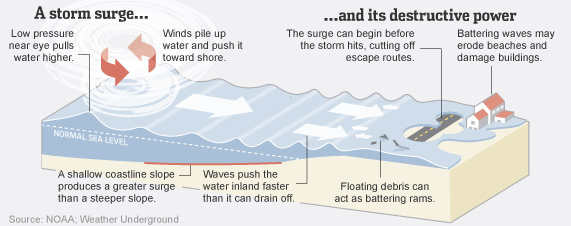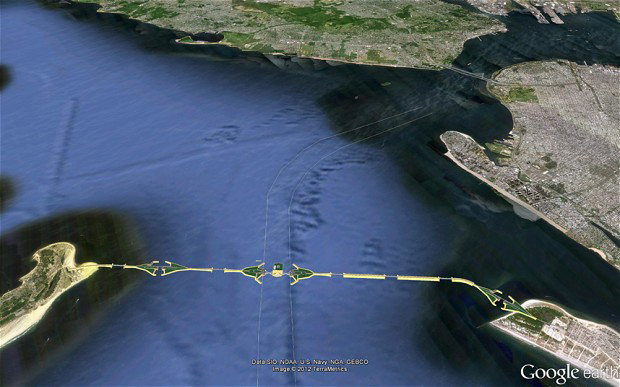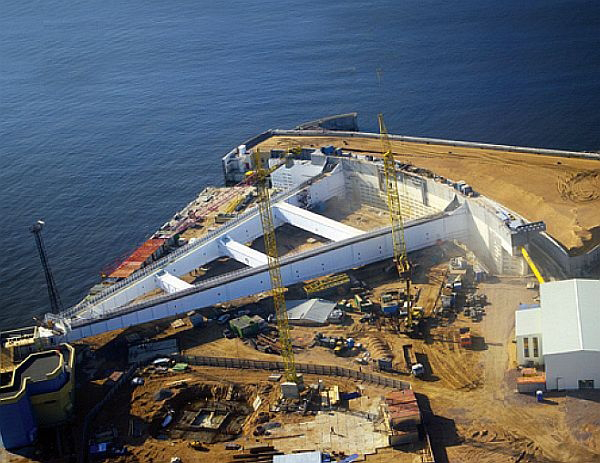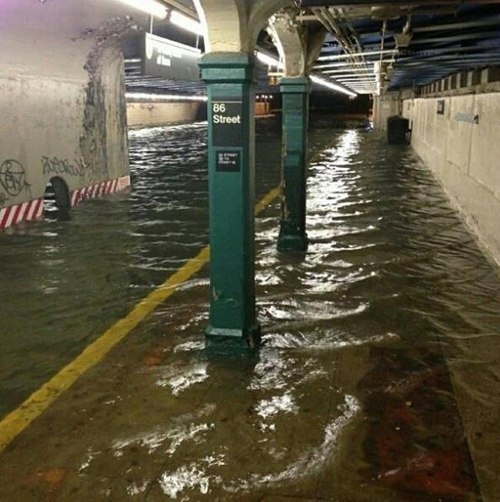SBU SoMAS researcher to give post-Sandy lecture at Stony Brook Southampton on Friday, November 16, 2012
New York, NY, November 16, 2012 - The post-Sandy media blitz all began with the November 1st Associated Press article "Experts Say NYC Barrier Could Have Stopped Surge." In it, Stony Brook University (SBU) oceanography professor and storm surge expert Dr. Malcolm Bowman said, "The time has come. The city is finally going to have to face this."
Bowman is referring to the "new normal" many have said we are faced with following the damage left behind by superstorm Sandy. It was a storm that Bowman and other investigators in SBU's School of Marine and Atmospheric Sciences (SoMAS) Storm Surge Research Group tracked extensively while it traveled up the U.S. East Coast late last month. During superstorm Sandy, predictions by this Group were used by government agencies across the region for the purposes of evacuations and shut-downs.
For the last decade, New York Sea Grant (NYSG) has provided principal funding to the Group to work on storm surge science, coastal defense systems and policy issues related to regional protection of New York City and Long Island. The Group was initially formed to develop coastal early warning system for emergency response against flooding in Metropolitan New York.
Data that the Research Group provided on Sandy - which was first reported via E-mail, the Research Group's Web site, and NYSG's Twitter and Facebook feeds during the storm - will be the focus of Group Director Bowman's discussion at Stony Brook Southampton tonight, "Storm Surge from Superstorm Sandy: Causes and Impacts."
During Friday's lecture, Bowman will describe how superstorm Sandy developed, how it lead to the enormous storm surge that devastated the region, what the precise impacts were, how it could have been even worse, and what Metropolitan New York should do to protect against future events. The 7:30 p.m. talk, part of SBU Southampton's SOMAS Fall 2012 Public
Lecture Series, will be held at Duke Lecture Hall in Chancellor’s Hall.
It will be preceded and followed with a reception.

A storm surge is the rise of water driven toward shore by storm winds, over and above predicted tide levels, according to the National Oceanic and Atmospheric Administration. Storm-surge flooding varies widely, depending on the height of terrain along local coastlines.
"The New York Metropolitan region is vulnerable to coastal flooding and large-scale damage to city infrastructure from hurricanes, nor'easters, and other severe storms like Sandy," said Bowman. He reminds that much of this region lies less than three meters above mean sea level. Within this area - which, in total, includes an area of about 260 square kilometers -lies critical infrastructure such as hospitals, airports, railroad and subway station entrances, highways, water treatment outfalls and combined sewer outfalls at or near sea level.
Bowman is a long-standing expert on issues related to severe storms like Sandy, as seen in the May 2011 SBU Provost's lecture, "Tsunami: Could It Happen to Us?"
SBU Provost Lecture - Malcolm Bowman: Tsunami: Could It Happen To Us? (May 2011)
Click here for NYSG's related news item/transcript
During the talk, Bowman was asked if the metro New York area could be at risk as a tsunami hazard zone? "Yes and no," depending on how long we look into the future," he said. Looking back on the past 60 years or so, Bowman cited two powerful storms that caused a storm surge to flood portions of New York City - one in November of 1950 that left LaGuardia Airport flooded and a nor'easter in December 1992 that left the FDR Drive under water and seawater flooded the Hoboken train station and the PATH train systems and also inundated and shut down the New York City subway system for several days.
Bowman said that we could learn a lot from the Dutch, whose major cities of Amsterdam and Rotterdam are six feet below sea level and whose hydraulic engineers are looking to protect the country against a monster storm that could occur every 10,000 years.
"Building codes need to be updated in New York City." Present codes are designed for 1-in-100-year storms. This should be upgraded to 1-in-250 or 1-in-500-year storms. How do you evacuate two to three-million people if one train station floods with sea water and all of the power goes off?"

(Pictured above) Barrier gates at the Ambrose Channel, the main shipping channel in and out of the Port of New York and New Jersey, as conceived by New York City-based Halcrow, one of only four companies from around the world invited to present concept designs for barrier defenses against surge flooding at a conference organized by the American Society of Civil Engineers in March 2009. As detailed in the company's details for the proposed project: "Considering the importance of the New York Harbor to the regional economy, it is critical the proposed storm surge barrier does not interfere with vessel traffic, during both construction and operation. Therefore barrier gates at the Ambrose Channel must be sufficiently deep to accommodate not only today’s vessels, but also potentially larger vessels which may call at New York in the future." Photo courtesy of Malcolm Bowman.

(Pictured above) A rendition of the concept an outer-New York Harbor flood defense barrier by The Halcrow Group, Bowman's support for which is documented in their related Web resource "Concept Storm Surge Barrier" (pdf).
Though proposals from other firms call for a storm surge barrier across the Verrazano Narrows between Brooklyn and Staten Island, Bowman says recent research indicates the the Verrazano location is not a good choice. "There are a number of reasons," he says, citing that the channel is too deep, currents are too swift, and the barrier does not protect southern Staten Island, or locations in Queens such as Breezy Point, Jamaica Bay and the JFK airport. Photo courtesy of Malcolm Bowman.

The St. Petersburg, Russia flood defense barrier (pictured above and below). Scientists like Bowman say the experiences of such projects here, as well as in London, and Venice, Italy, show the systems can protect dense urban populations and infrastructure from storm surges and floods. Photos courtesy of Malcolm Bowman.

Below is a 20-second video clip of a concept barrier for New York City from the Dutch engineering firm Arcadis.
Superstorm Sandy: Malcolm in the Media
As Bowman stressed in the Associated Press article on November 1, 2012 (pdf), analysis of his SBU Research Group's data and studies over time have shown that the type of sea walls that protect major cities in Europe could have helped to minimize the severe damage that resulted from New York's storm surge. Though the multibillion-dollar price tag of such a project has been a hindrance, Bowman and other scientists feel it may appear more palatable as the damage from superstorm Sandy continues to be tallied.
Aside from the cost, though, there are other concerns over the construction of such barriers. "Who gets included to be behind the gate, and who doesn't get included? ... How do you make that decision in a fair way?" Larry Swanson, Associate Dean at SoMAS and Bowman's colleague at Stony Brook, said in an August interview (which was cited in the November 1st Associated Press article).
There are other measures that could be taken in the metro New York area to minimize impact, too. These include elevating mass transit infrastructure - such as raising subway entrances a meter or more off the ground and including a stairway from the sidewalk that passengers need to walk up before heading down in the metro (as seen in the picture of the Bangkok subway below, courtesy of Waerth/Wikimedia Commons). Making such modifications could prevent extensive flooding of New York City's subway system, such as seen in the second picture below from the 86th Street station after Sandy passed through the metro New York area.


The New York MTA has also experimented in the past with elevating the grates that ventilate the subway system, another piece of transit infrastructure susceptible to flooding. Several years ago, the MTA commissioned architecture firm Rogers Marvel to design prototype elevated subway vents that would double as street furniture (as seen in the picture below, courtesy of the MTA).
For more suggestions on how the City can better prepare for flooding events related to storms such as Sandy, see The Atlantic's October 31, 2012 article "5 Ideas That Could Have Prevented Flooding in New York" (pdf) and the November 2, 2012 article "What It Would Take to Hurricane-Proof New York" (pdf).

In the weeks following Sandy, Bowman discussed the storm's aftermath, the idea of storm surge barriers and other possible next steps on a number of television networks, including NBC and ABC News.
As Bowman spoke about in one of the NBC segments, storm surges have hit the region before — most notably with the deadly nor'easter of December 1992, and to a lesser extent with Hurricane Irene last year. But Sandy was much more dangerous, dubbing it "The Perfect Storm."
"What happened on Monday [October 29] night is that the maximum surge occurred at high tide, and it also happened to be a full moon," Bowman said. "All those events came to coincide, and that's what made it so bad. If the storm had hit six hours later, it would have been low tide, and there would have been less damage. Timing is everything."
Bowman provides a more in-depth discussion about the need for storm surge barriers, including where he suggests the first ones should go in the New York region, in the various television clips. A playlist of these is below. Also, see the list below, where individual transcripts and video are provided for each:
NBC News - Cosmic Blog (October 30, 2012)
"NYC flood was foreseen: Now what?" (Click Here)
NBC News - Rock Center with Brian Williams (November 1, 2012)
"Hurricane Sandy provides 'wake-up call' for cities at risk of flooding" (Click Here)
ABC News (November 2, 2012)
"Superstorm Sandy Spurs Talk of Sea Barrier for New York" (Click Here)
Bowman also took to the air, talking with National Public Radio's Steve Inskeep about flooding from Sandy, and the possibility of creating storm barriers around New York. A week later, Bowam was also a guest on NRP's On Point, an hour-long discussion program on which he and others talked about the possibility of barricading New York against a rising sea. Transcripts, audio and video are provided for each here:
National Public Radio (November 1, 2012)
"Protecting New York From Future Flooding" (Click Here)
NPR On Point (November 8, 2012)
"In the wake of Hurricane Sandy, New York looks at sea walls" (Click Here)
A number of other media outlets printed stories before, during and after superstorm Sandy was in the metro New York area. These articles, all listed below, featured Bowman as well as fellow SBU Storm Surge Research Group investigator Brian Colle. They include several articles each in The New York Times and Newsday as well as stories in The Wall Street Journal, Scientific American, The New Yorker and Bloomberg News, among others:
International Business Times (October 28, 2012) (pdf)
"Hurricane Sandy Forecasters Warn Of Storm's Size; 'Frankenstorm' Expected To Grow"
Newsday (October 28, 2012) (pdf)
"As Hurricane Sandy turns into 'Frankenstorm,' experts explain the rare convergence"
The Wall Street Journal (October 29, 2012) (pdf)
"Range of Events Feeds Surge"
Bloomberg News (October 30, 2012) (pdf)
"High-Tide Storm Was a Known Risk for New York"
Newsday (October 30, 2012) (pdf)
"Sandy ranks as historic storm: weather experts"
CNN (October 31, 2012) (pdf)
"Experts warn of superstorm era to come"
The New York Times (October 31, 2012) (pdf)
"For Years, Warnings That It Could Happen Here"
The New York Times "Assessing the Damage From Hurricane Sandy" (pdf)
Diagrams and details on NYC subways/buses, tunnels/trains/airports, wastewater, flooding, fires and wind as a result of the superstorm
The Associated Press (November 1, 2012) (pdf)
"Experts Say NYC Barrier Could Have Stopped Surge"
CNBC (via AP wire) (November 1, 2012) (pdf)
"Storm Invigorates Proponents of NYC Sea Barrier"
National Public Radio (via AP wire) (November 1, 2012) (pdf)
"Experts: NYC Sea Barrier Could Have Stopped Surge"
ClimateWire (November 1, 2012) (pdf)
"New York City's planning outran its adaptation"
Fox News (Latino) (November 1, 2012) (pdf)
"Hurricane Sandy: New York City Sea Barrier Could Have Stopped Surge, Experts Say"
Huffington Post (November 2, 2012) (pdf)
"Hurricane Sandy Utility Outages May Be Worsened By Underinvestment, Lack Of Planning"
Telegraph UK (November 2, 2012) (pdf)
"Massive barrier plan to save New York from flooding"
Co.Exist.com (November 4, 2012) (pdf)
"How Can New York Prepare For The Next Hurricane Sandy?"
The New York Times (November 4, 2012) (pdf)
"Engineers’ Warnings in 2009 Detailed Storm Surge Threat to the Region"
The Washington Post (November 4, 2012) (pdf)
"Coastal cities seek protections against superstorms"
Reuters (November 4, 2012) (pdf)
"Flooded New York plans to tame the sea, but who pays?"
E&T Magazine (November 5, 2012) (pdf)
"Engineers warned New York about Sandy-style flood threat"
International Business Times (November 5, 2012) (pdf)
"How Do You Protect Cities Against Future Storms Like Sandy?"
Scientific American (November 5, 2012) (pdf)
"How Can New York Prepare For The Next Hurricane Sandy?"
Nature (November 6, 2012) (pdf)
"Hurricane sweeps US into climate-adaptation debate"
The New York Times: Green Blog (November 6, 2012) (pdf)
"The Big Barrier Question"
Salon.com (November 6, 2012) (pdf)
"Sandy recovery: Walls won’t stop superstorms"
Yale Environment 360 (November 6, 2012) (pdf)
"Battered New York City Looks For Ways to Hold Back the Sea"
The New York Times (November 7, 2012) (pdf)
"Weighing Sea Barriers as Protection for New York"
Bloomberg News (November 9, 2012) (pdf)
"Billions on Flood Barriers Now Might Save New York City"
The Real Deal (November 9, 2012) (pdf)
"NYC floodgates would cost billions. Some scientists insist they’re worth it"
New Scientist (November 10, 2012) (pdf)
"Protecting New York City from the next big storm"
NBC.com (November 10, 2012) (pdf)
"Ideas on protecting New York from future storms float to surface"
https://seagrant.sunysb.edu/media/sandy12/NBC-Sandy111012.pdf
The Huffington Post (November 12, 2012) (pdf)
"Hurricane Sandy Damage Amplified By Breakneck Development Of Coast"
[cites information from Bloomberg News article on October 30, 2012]
LI Herald (November 12, 2012) (pdf)
"Clearing up Sandy’s confusion"
The New Yorker (November 12, 2012) (pdf)
"Crossing the Line"
Christian Science Monitor (November 13, 2012) (pdf)
"How will New York keep out a rising sea? Dikes, huge sea wall, oyster beds?"
Southampton Patch (November 13, 2012) (pdf)
"Stony Brook Professor to Discuss Sandy Storm Surge"
Discovery News (November 14, 2012) (pdf)
"Time to Bring Back New York's Oysters"
The NY Daily News (November 15, 2012) (pdf)
"How Dutch innovations could prevent Sandy-type flooding in New York"